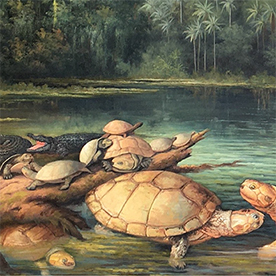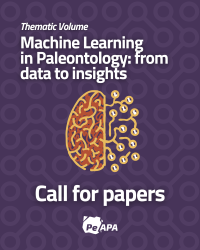WIDER PALEOGEOGRAPHICAL DISTRIBUTION OF BOTHREMYDID TURTLES IN NORTHERN SOUTH AMERICA DURING THE PALEOCENE–EOCENE
DOI:
https://doi.org/10.5710/PEAPA.14.02.2024.499Keywords:
Testudines, Colombia, Paleobiogeography, Bothremydidae, Arcillolitas de Socha FormationAbstract
Bothremydidae was one of the most diverse and widespread group of side-necked turtles (pleurodirans) during the Cretaceous and part of the Paleogene. In South America, the Paleogene record of bothremydids is restricted to Puentemys mushaisaensis from the middle–late Paleocene Cerrejón Formation of Colombia, Inaechelys pernambucensis from the Paleocene of Brazil, and Motelomama olssoni from the early Eocene of Perú. Here, we describe two shells of P. mushaisaensis and several other isolated bones conferred to this taxon from the upper Paleocene and lower Eocene Arcillolitas de Socha Formation found in the Socha Region, Boyacá Department of Colombia. U-Pb dating of detrital zircon from two levels from this formation indicates maximum depositional ages of 56.83±0.04 Ma and 57.2±0.5 Ma for the areniscas guía interval of the formation. The new occurrence of P. mushaisaensis in the Socha region, at least 500 km south from Cerrejón, indicates a wider biogeographical distribution of northern South America Paleocene herpetofauna, possibly helped by low topography and ecosystems connectivity via a faunistic corridor.
References
Alvarado, B., and Sarmiento, R. (1944). Informe geológico general sobre los yacimientos de hierro, carbón y caliza de la región de Paz de Río, departamento de Boyacá. Bogotá, Colombia: Servicio Geológico Nacional, Bogotá.
Batsch, A. J. G. C. (1788). Versuch einer Anleitung zur Kenntniss und Geschichte der Thiere und Mineralien. Erster Theil. Akademische Buchhandlung, Jena.
Baur, G. (1891). Notes on some little-known American fossil tortoises. Proceedings of the Academy of Natural Science of Philadelphia, 43, 411–430.
Bayona, G. (2018). The onset of the mountain uplift in the northern Andes: A perspective based on Coniacian to Paleocene tectono-sedimentary studies. Revista de la Academia Colombiana de Ciencias Exactas Físicas y Naturales, 42, 364–378.
Bayona, G., Baquero, M., Ramírez, C., Tabares, M., Salazar, A. F., Nova, G., Duarte, E., Pardo, A., Plata, A., Jaramillo, C., Rodríguez, G., Caballero, V., Cardona, A., Montes, C., Gómez-Marulanda, S., and Cárdenas-Rozo, A. (2021). Unraveling the widening of the earliest Andean northern orogen: Maastrichtian to early Eocene intra-basinal deformation in the northern Eastern Cordillera of Colombia. Basin Research, 33, 809–845. https://doi.org/10.1111/bre.12496
Cadena, E.A., Bloch, J.I., and Jaramillo, C.A. (2012). New bothremydid turtle (Testudines, Pleurodira) from the Paleocene of northeastern Colombia. Journal of Paleontology, 86, 688–698. https://doi.org/10.1666/11-128R1.1
Cadena, E.A., Scheyer, T.M., Carrillo-Briceño, J.D., Sánchez, R., Aguilera-Socorro, O.A., Vanegas, A., Pardo, M., Hansen, D.M., Sánchez-Villagra, M.R. (2020). The anatomy, paleobiology, and evolutionary relationships of the largest extinct side-necked turtle. Science Advances 6, eaay4593. https://doi.org/10.1126/sciadv.aay4593
Cottle, J. M., Kylander-Clark, A. R. C., and Vrijmoed, J. C. (2012). U-Th/Pb geochronology of detrital zircon and monazite by Single Shot Laser Ablation Inductively Coupled Plasma Mass Spectrometry (SS-LA-ICPMS). Chemical Geology, 332–333, 136–147. https://doi.org/10.1016/j.chemgeo.2012.09.035
Cottle, J. M., Burrows, A. J., Kylander-Clark, A. R. C., Freedman, P. A. and Cohen, R. (2013). Enhanced sensitivity in laser ablation multi-collector inductively coupled plasma mass spectrometry. Journal of Analytical Atomic Spectrometry, 28, 1700–1706.
Cope, E. D. (1864). On the limits and relations of the Raniformes. Proceedings of the Academy of Natural Science of Philadelphia, 16, 181–183.
Ferrón, H. G., Martínez-Pérez, C., and Botella, H. (2017). The evolution of gigantism in active marine predators. Historical Biology, 30, 712–716. https://doi.org/10.1080/08912963.2017.1319829
Gaffney, E. S., Tong, H., and Meylan, P. A. (2006). Evolution of the side-necked turtles: the families Bothremydidae, Euraxe¬mydidae, and Araripemydidae. Bulletin of the American Museum of Natural History, 300, 1–700. https://doi.org/dgxpvn
Jaramillo, C. A., and Dilcher, D. L. (2001). Middle Paleogene palynology of central Colombia, South America: A study of pollen and spores from tropical latitudes. Palaeontographica Abt. B, 258, 87–213.
Kylander-Clark, A. R. C., Hacker, B. R., and. Cottle, J. M (2013). Laser-ablation split-stream ICP petrochronology. Chemical Geology, 345, 99–112. https://doi.org/10.1016/j.chemgeo.2013.02.019
Lapparent de Broin, F. de. (2000). African chelonians from the Jurassic to the present. A preliminary catalog of the African fossil chelonians. Palaeontologia Africana, 36, 43–82.
Lapparent de Broin, F. de., Métais, G., Bartolini, A., Brohi, I. A., Lashari, R. A., Marivaux, L., Merle, D., Warar, M. A. and Solangi S. H. (2021). First report of a bothremydid turtle, Sindhochelys ragei n. gen., n. sp., from the early Paleocene of Pakistan, systematic and palaeobiogeographic implications. In Steyer, J.-S., Augé, M. L. and Métais G. (eds), Memorial Jean-Claude Rage: A life of paleoherpetologist. Geodiversitas, 43 (25), 1341–1363. https://doi.org/10.5252/geodiversitas2021v43a25.
Maher, A. E., Burin, G., Cox, P. G., Maddox T. W., Maidment S. C. R., Cooper, N., Schachner E., and Bate, K. T. (2022). Body size, shape and ecology in tetrapods. Nature Communications, 13, 4340. https://doi.org/10.1038/s41467-022-32028-2
Mattinson, J. M. (2005). Zircon U-Pb chemical abrasion ("CA-TIMS") method: combined annealing and multi-step partial dissolution analysis for improved precision and accuracy of zircon ages. Chemical Geology, 220, 47–66. https://doi.org/10.1016/j.chemgeo.2005.03.011
Paleobiology Database, accessed November 15, (2023). https://paleobiodb.org/#/
Pérez-García, A. (2016). A new turtle taxon (Podocnemidoidea, Bothremydidae) reveals the oldest known dispersal event of the crown Pleurodira from Gondwana to Laurasia. Journal of Systematic Palaeontology, 15 (9), 1–23. https://doi.org/10.1080 /14772019.2016.1228549
Pérez-García, A. (2016). New genera of Taphrosphyina (Pleurodira, Bothremydidae) for the French Maastrichtian ‘Tretosternum’ ambiguum and the Peruvian Ypresian ‘Podocnemis’ olssoni. Historical Biology. https://doi.org/10.1080/08912963.2018.1506779
Pérez-García, A. (2018). New information on the Cenomanian bothremydid turtle Algorachelus based on new, well-preserved material from Spain. Fossil Record, 21, 119–135. https://doi. org/10.5194/fr-21-119-2018
Pérez-García, A. (2020). First evidence of a bothremydid turtle (crown Pleurodira) in the middle Cretaceous of Castile and Leon (Spain). Journal of Iberian Geology. https://doi.org/10.1007/s41513-020-00146-9
Pérez-García, A., Antunes, M. T., Barroso-Barcenilla, F., Cal¬lapez, P. M., Segura, M., Soares, A. F. and Torices, A. (2017). A bothremydid from the middle Cenomanian of Portugal identified as one of the oldest pleurodiran turtles in Laurasia. Cretaceous Research, 78, 61–70. https://doi.org/10.1016/j.cretres.2017.05.031
Schmidt, K. P. (1931). A fossil turtle from Peru. Field Museum Natural History Geolo. Ser. 4, 251–254.
Scheyer, T. M., Aguilera, O. A., Delfino, M., Fortier, D. C., Carlini, A. A., Sánchez, R., Carrillo-Briceño, J. D., Quiroz, L., Sánchez-Villagra, M.R. (2013). Crocodylian diversity peak and extinction in the late Cenozoic of the northern Neotropics. Nature Communications, 4, 1907. https://doi.org/10.1038/ncomms2940
Ulloa, C., and Rodríguez, E. (2003). Memoria de la plancha 172 Paz de Río, Bogotá, Colombia, INGEOMINAS. https://catalogo.sgc.gov.co/cgi-bin/koha/opac-detail.pl?biblion
Van Der Hammen, T. (1957). Estratigrafía palinológica de la Sabana de Bogotá, Cordillera Oriental de Colombia. Bogotá, Colombia, Boletín Geológico, Servicio Geológico Nacional.
Velandia-Angarita, O. R., Mariño-Martínez, J. E. and Giraud-López, M. J. (2023). Litoestratigrafía y bioestratigrafía como herramientas de exploración de fósiles de vertebrados en Socha (Colombia) Revista EIA, 20(40), 1–20. https://doi.org/10.24050/reia.v20i40.1700
Vermeij, G. J. (2016). Gigantism and its implications for the history of life. PLOS ONE, 11, e0146092.
Westerhold, T., Röhl, U., Frederichs, T., Agnini, C., Raffi, I., Zachos, J. C., and Wilkens, R. H. (2017). Astronomical calibration of the Ypresian timescale: implications for seafloor spreading rates and the chaotic behavior of the solar system? Climate of the Past, 13(9), 1129–1152. https://doi.org/10.5194/cp-13-1129-2017

Additional Files
Published
Issue
Section
License
Copyright (c) 2024 Edwin-Alberto Cadena, Byron Benítez, Francisco Emmanuel Apen, James Leahey Crowley, John Cottle, Carlos Jaramillo

This work is licensed under a Creative Commons Attribution-NoDerivatives 4.0 International License.
Authors retain copyright and grant the journal right of first publication with the work simultaneously licensed under a Atribución/Reconocimiento 4.0 Internacional that allows others to share the work with an acknowledgement of the work's authorship and initial publication in this journal.
















